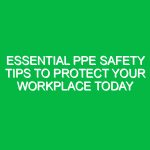Understanding PPE: What Is It?
Personal Protective Equipment (PPE) is a critical component in the Health, Safety, and Environment (HSE) domain, designed to protect workers from various hazards encountered in their workplace. But what exactly is PPE? At its core, PPE encompasses a variety of gear, clothing, and equipment intended to minimize exposure to dangers that can cause serious injuries or illnesses. These hazards can range from chemical spills to physical impacts, and even biological threats, making the correct usage of PPE vital for workplace safety.
The relevance of PPE in HSE cannot be overstated. With the increasing complexity of workplace environments and the multitude of potential risks, understanding and implementing effective PPE measures is crucial for safeguarding employees. In this article, we will explore the essential aspects of PPE in the HSE context, its applications, regulations, and best practices, ensuring a comprehensive understanding of how to unlock safety secrets for success.
The Key Aspects of PPE in HSE
Types of PPE
PPE is categorized into several types based on the specific hazards it addresses. Each type serves a unique purpose, and understanding these categories is fundamental for effective implementation. The main types of PPE include:
- Head Protection: Hard hats and helmets prevent head injuries from falling objects or collisions.
- Eye and Face Protection: Safety goggles, face shields, and other eyewear protect against flying debris, chemicals, and radiation.
- Hearing Protection: Earplugs and earmuffs shield against harmful noise levels in various work environments.
- Respiratory Protection: Masks and respirators safeguard against inhaling hazardous substances or airborne particles.
- Hand Protection: Gloves made from different materials protect against cuts, chemicals, and thermal hazards.
- Foot Protection: Steel-toed boots and other footwear prevent injuries from heavy objects and slippery surfaces.
- Body Protection: Coveralls, aprons, and other garments shield against chemical spills, heat, and sharp objects.
Each of these categories plays a vital role in ensuring worker safety across various industries. For example, during a construction project, a hard hat is non-negotiable, while in a laboratory setting, safety goggles are essential to prevent chemical splashes. Understanding the specific needs of your workplace is the first step towards effective PPE selection.
The Importance of Proper Fit and Maintenance
An often-overlooked aspect of PPE is the importance of proper fit and maintenance. PPE that does not fit well can become uncomfortable, leading to improper use or even abandonment. For instance, a loose helmet may fall off during an impact, while gloves that are too tight can impede dexterity and lead to accidents.
Moreover, maintaining PPE is crucial for ensuring its effectiveness. Regular inspections, cleaning, and proper storage can extend the life of protective gear and guarantee it functions as intended. For example, a safety harness used in construction must be checked for frays or weaknesses before each use to prevent falls.
Potential Hazards and Risks
PPE is only effective if it is appropriately selected and used in conjunction with other safety measures. Identifying potential hazards in the workplace is a crucial step in determining the right PPE. Common workplace hazards include:
- Chemical Hazards: Exposure to harmful substances can occur in various industries, from manufacturing to healthcare.
- Physical Hazards: These include slips, trips, falls, and injuries from machinery or tools.
- Biological Hazards: Healthcare workers, for instance, face risks related to bloodborne pathogens.
- Ergonomic Hazards: Poorly designed workstations can lead to repetitive strain injuries over time.
An example of PPE in action can be drawn from a case study in a chemical plant, where improper handling of corrosive substances resulted in skin burns among workers. After a thorough risk assessment, the company implemented strict PPE protocols, including the mandatory use of chemical-resistant gloves and suits. The result was a significant reduction in workplace injuries and a safer working environment.
Best Practices for PPE Usage
To maximize the effectiveness of PPE, organizations should adopt best practices that encompass training, selection, and compliance:
- Training: Workers must be trained on the correct use, maintenance, and limitations of PPE.
- Selection: Perform hazard assessments to determine the appropriate PPE for specific tasks.
- Compliance: Ensure that all employees adhere to PPE protocols consistently.
A personal anecdote from a safety officer illustrates this point. During a safety audit at a manufacturing facility, it became evident that workers were not wearing their gloves correctly. This oversight led to several near-misses. After conducting a training session emphasizing the importance of proper glove usage and fit, the facility saw a marked improvement in compliance and a decrease in incidents.
Regulations and Standards Governing PPE
Several regulations and standards govern the use of PPE in the workplace, with the Occupational Safety and Health Administration (OSHA) being one of the primary regulatory bodies in the United States. OSHA mandates that employers provide appropriate PPE to their employees at no cost, ensuring that safety is prioritized over profit. Additionally, the American National Standards Institute (ANSI) sets forth standards for the performance and testing of PPE, providing guidelines for manufacturers and users alike.
Compliance with these regulations not only protects workers but also shields organizations from potential legal repercussions. For instance, a construction firm that fails to provide adequate PPE could face hefty fines and lawsuits in the event of an accident. Understanding and adhering to these regulations is essential for fostering a culture of safety and accountability.
Conclusion
In conclusion, PPE is an indispensable element of health, safety, and environmental management. Understanding what PPE is and how it applies within the workplace is vital for protecting employees from a multitude of hazards. From selecting the appropriate gear to ensuring proper fit and maintenance, every element plays a crucial role in the overarching goal of workplace safety.
By adhering to best practices, complying with regulations, and fostering a culture of safety, organizations can unlock the secrets to HSE success. The commitment to PPE not only promotes worker safety but also enhances overall productivity and morale. It is imperative for both employers and employees to view PPE not merely as a requirement but as a fundamental aspect of a safe and healthy work environment. As we move forward, let us continue to prioritize safety, ensuring that every worker returns home safely at the end of the day.


